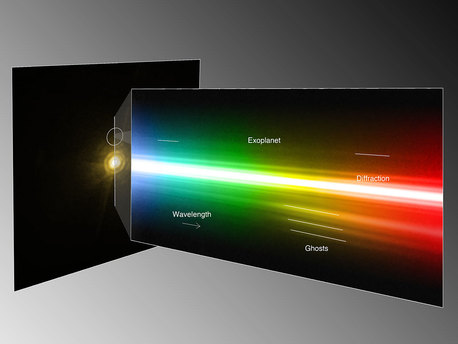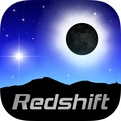VLT Captures Direct Spectrum
Groundbreaking Exploration of Exoplanets
 © ESO/M. Janson
|
This montage shows the image and the spectrum of the star and the planet as seen with the NACO adaptive optics instrument on ESO’s Very Large Telescope. As the host star is several thousand times brighter than the planet, this is a remarkable achievement at the border of what is technically possible. According to the scientists it is like trying to see what a candle is made of, by observing it from a distance of two kilometres when it’s next to a blindingly bright 300 Watt lamp.
The researchers obtained the spectrum of a giant exoplanet that orbits the bright, very young star HR 8799. The system is at about 130 light-years from Earth. The star has 1.5 times the mass of the Sun, and hosts a planetary system that resembles a scaled-up model of our own Solar System. Three giant companion planets were detected in 2008 by another team of researchers, with masses between 7 and 10 times that of Jupiter. They are between 20 and 70 times as far from their host star as the Earth is from the Sun; the system also features two belts of smaller objects, similar to our Solar System's asteroid and Kuiper belts.
“Our target was the middle planet of the three, which is roughly ten times more massive than Jupiter and has a temperature of about 800 degrees Celsius,” says team member Carolina Bergfors. “After more than five hours of exposure time, we were able to tease out the planet's spectrum from the host star's much brighter light.”
This is the first time the spectrum of an exoplanet orbiting a normal, almost Sun-like star has been obtained directly. Previously, the only spectra to be obtained required a space telescope to watch an exoplanet pass directly behind its host star in an “exoplanetary eclipse”, and then the spectrum could be extracted by comparing the light of the star before and after. However, this method can only be applied if the orientation of the exoplanet’s orbit is exactly right, which is true for only a small fraction of all exoplanetary systems. The present spectrum, on the other hand, was obtained from the ground, using ESO’s Very Large Telescope (VLT), in direct observations that do not depend on the orbit’s orientation.
As the host star is several thousand times brighter than the planet, this is a remarkable achievement. “It's like trying to see what a candle is made of, by observing it from a distance of two kilometers when it’s next to a blindingly bright 300 Watt lamp,” says Janson.
The newly collected data show that the atmosphere enclosing the planet is still poorly understood. “The features observed in the spectrum are not compatible with current theoretical models,” explains co-author Wolfgang Brandner. “We need to take into account a more detailed description of the atmospheric dust clouds, or accept that the atmosphere has a different chemical composition from that previously assumed.”
The astronomers hope to soon get their hands on the fingerprints of the other two giant planets so they can compare, for the first time, the spectra of three planets belonging to the same system. “This will surely shed new light on the processes that lead to the formation of planetary systems like our own,” concludes Janson.
Source: ESO
VLT Captures Direct Spectrum
Groundbreaking Exploration of Exoplanets
 © ESO/M. Janson
|
This montage shows the image and the spectrum of the star and the planet as seen with the NACO adaptive optics instrument on ESO’s Very Large Telescope. As the host star is several thousand times brighter than the planet, this is a remarkable achievement at the border of what is technically possible. According to the scientists it is like trying to see what a candle is made of, by observing it from a distance of two kilometres when it’s next to a blindingly bright 300 Watt lamp.
The researchers obtained the spectrum of a giant exoplanet that orbits the bright, very young star HR 8799. The system is at about 130 light-years from Earth. The star has 1.5 times the mass of the Sun, and hosts a planetary system that resembles a scaled-up model of our own Solar System. Three giant companion planets were detected in 2008 by another team of researchers, with masses between 7 and 10 times that of Jupiter. They are between 20 and 70 times as far from their host star as the Earth is from the Sun; the system also features two belts of smaller objects, similar to our Solar System's asteroid and Kuiper belts.
“Our target was the middle planet of the three, which is roughly ten times more massive than Jupiter and has a temperature of about 800 degrees Celsius,” says team member Carolina Bergfors. “After more than five hours of exposure time, we were able to tease out the planet's spectrum from the host star's much brighter light.”
This is the first time the spectrum of an exoplanet orbiting a normal, almost Sun-like star has been obtained directly. Previously, the only spectra to be obtained required a space telescope to watch an exoplanet pass directly behind its host star in an “exoplanetary eclipse”, and then the spectrum could be extracted by comparing the light of the star before and after. However, this method can only be applied if the orientation of the exoplanet’s orbit is exactly right, which is true for only a small fraction of all exoplanetary systems. The present spectrum, on the other hand, was obtained from the ground, using ESO’s Very Large Telescope (VLT), in direct observations that do not depend on the orbit’s orientation.
As the host star is several thousand times brighter than the planet, this is a remarkable achievement. “It's like trying to see what a candle is made of, by observing it from a distance of two kilometers when it’s next to a blindingly bright 300 Watt lamp,” says Janson.
The newly collected data show that the atmosphere enclosing the planet is still poorly understood. “The features observed in the spectrum are not compatible with current theoretical models,” explains co-author Wolfgang Brandner. “We need to take into account a more detailed description of the atmospheric dust clouds, or accept that the atmosphere has a different chemical composition from that previously assumed.”
The astronomers hope to soon get their hands on the fingerprints of the other two giant planets so they can compare, for the first time, the spectra of three planets belonging to the same system. “This will surely shed new light on the processes that lead to the formation of planetary systems like our own,” concludes Janson.
Source: ESO






